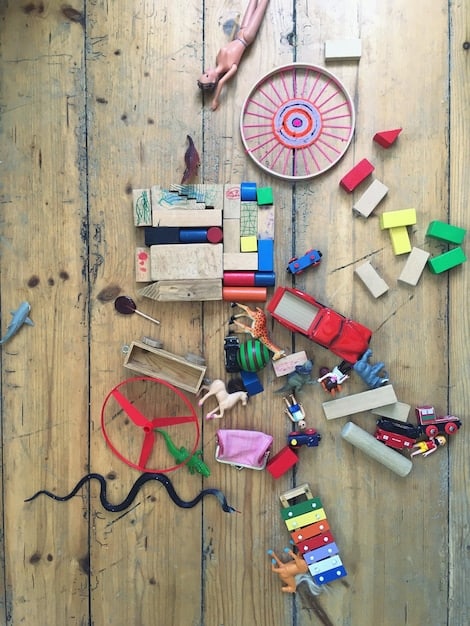Is Your Child Ready for Independent Play? 5 Milestones in 2025

Determining if your child is ready for independent play in 2025 involves observing key developmental milestones such as the ability to focus, problem-solving skills, understanding safety rules, demonstrating emotional resilience, and engaging in imaginative activities without constant adult supervision.
Is your child nearing an age where you’re considering letting them play independently? Determining readiness for solo playtime is a crucial step in fostering their development, and knowing the key milestones can help. Let’s explore the markers that indicate **Is Your Child Ready for Independent Play? 5 Key Milestones to Watch for in 2025**.
Understanding Independent Play: More Than Just Alone Time
Independent play is often mistaken as simply leaving a child alone with toys. However, it’s a multifaceted activity that involves self-directed engagement, creativity, and problem-solving. It’s a cornerstone of early childhood development, equipping children with essential life skills.
This type of play allows children to explore their interests without the constraints of adult direction, fostering a sense of autonomy and self-reliance. Understanding the nuances of independent play helps parents better assess their child’s readiness. Here’s what truly defines it:
The Definition of Independent Play
Independent play is when a child engages in an activity without needing guidance or interaction from others. It can involve toys, imagination, or even simple tasks, fostering creativity and problem-solving skills.
Why It Matters
Independent play is vital for several reasons. It enhances cognitive development, boosts creativity, and encourages self-sufficiency. Children learn to entertain themselves, manage their emotions, and develop unique problem-solving strategies.
- Boosts Creativity: Children come up with their own games and scenarios.
- Enhances Problem-Solving Skills: They learn to overcome challenges independently.
- Encourages Self-Sufficiency: Kids become comfortable relying on their own resources.
Recognizing the significance of independent play is just the first step. Parents must also consider the developmental milestones that indicate readiness.
Independent play is not simply about isolation; it’s about empowering a child to explore their world on their own terms, fostering imagination and self-reliance. It’s an important skill that prepares them for future challenges.
Milestone 1: Sustained Focus and Engagement
One of the primary indicators that a child is ready for independent play is their ability to focus on an activity for a reasonable period. This isn’t just about keeping still; it’s about genuine engagement and interest in what they are doing.
Sustained focus allows children to delve deeper into their play, explore different aspects of an activity, and derive greater satisfaction from their accomplishments. It is a critical marker of cognitive and emotional maturity.
What to Look For
Observe your child’s play habits. Do they flit from one toy to another, or can they spend a good chunk of time engrossed in a single activity? A child ready for independent play will show a clear preference for sustained engagement.
Setting Up for Success
Create an environment that encourages focus. Remove distractions, offer a variety of engaging toys, and allow your child the freedom to choose what they want to play with. This autonomy can significantly enhance their ability to concentrate.
- Minimize Distractions: A quiet space free from interruptions.
- Varied Toys: Provide options that capture their interests.
- Autonomy: Let them choose their activities.

By nurturing their ability to focus, you’re laying the foundation for successful independent play. This skill will serve them well in various aspects of their lives.
Sustained focus is more than mere concentration; it’s about engaging the mind in a meaningful way, fostering persistence and a love for learning. It’s a crucial ingredient for independent play.
Milestone 2: Problem-Solving Prowess
Independent play often presents children with various challenges: a tower of blocks that keeps toppling, a puzzle piece that doesn’t quite fit, or a toy that needs fixing. A child’s ability to navigate these problems independently is a powerful indicator of their readiness for solo playtime.
Problem-solving during play not only builds cognitive skills but also enhances resilience and perseverance. It teaches children that challenges are opportunities for growth and learning.
Assessing Problem-Solving Skills
When your child encounters a problem during play, resist the urge to immediately intervene. Instead, observe how they approach the situation. Do they try different solutions? Do they remain persistent, or do they give up easily?
Encouraging Self-Reliance
Support their problem-solving efforts by providing gentle prompts and encouragement, but allow them to find their own solutions. This approach builds confidence and reinforces their ability to handle challenges on their own.
- Observe, Don’t Intervene: Give them space to figure things out.
- Offer Gentle Prompts: Guide them without solving the problem for them.
- Praise Effort: Acknowledge their persistence and creativity.
A child who can independently tackle challenges during play is well-equipped to enjoy and benefit from solo playtime. It encourages them to become self-reliant and resourceful.
Problem-solving is a valuable life skill that extends far beyond the playroom. It prepares children to face real-world challenges with confidence and creativity. It’s an essential marker of readiness for independent play.
Milestone 3: Understanding and Following Safety Rules
Ensuring that a child understands and adheres to safety rules is paramount before allowing them to play independently. This includes both physical safety, such as avoiding dangerous items, and understanding boundaries, like not leaving the designated play area.
Safety awareness is not just about avoiding accidents; it’s about instilling a sense of responsibility and self-preservation. It ensures that they can navigate their environment safely and make sound decisions on their own.
Teaching Safety
Explicitly teach your child the safety rules that apply to their play area. Use clear and simple language, demonstrate safe practices, and regularly reinforce these lessons through gentle reminders and positive reinforcement.
Testing Comprehension
Periodically test their understanding of safety rules by asking them hypothetical questions or observing their behavior during play. If they consistently demonstrate an understanding of safety, they are likely ready for more independent playtime.
- Clear Instructions: Use simple and direct language.
- Demonstrate: Show them what safe behavior looks like.
- Regular Reinforcement: Remind them of the rules regularly.
By prioritizing safety, parents can create a secure environment where children can explore and learn with confidence. It’s a vital step towards fostering independence.

Safety is not merely a set of rules; it’s a mindset that empowers children to protect themselves and others. It’s a critical factor in determining their readiness for independent play.
Milestone 4: Emotional Resilience and Self-Soothing
Independent play can sometimes lead to frustration, disappointment, or even minor injuries. A child’s ability to cope with these emotions independently is an important indicator of their readiness for solo playtime.
Emotional resilience is about bouncing back from difficult emotions and finding healthy ways to self-soothe. It’s a crucial life skill that helps children manage stress and build confidence in their ability to overcome challenges.
Cultivating Resilience
Help your child develop emotional resilience by acknowledging their feelings, teaching them coping strategies, and providing a supportive environment where they feel safe expressing their emotions. This might include deep breathing exercises, talking about their feelings, or engaging in calming activities.
Observing Emotional Regulation
Pay attention to how your child responds to setbacks during play. Can they calm themselves down, find a solution to the problem, or move on to another activity without becoming overly distressed? These are signs of emotional resilience.
- Acknowledge Feelings: Validate their emotions.
- Teach Coping Strategies: Provide tools for managing stress.
- Supportive Environment: Create a safe space for expression.
Children who can handle their emotions independently are better equipped to enjoy solo playtime and benefit from the self-discovery it offers. It prepares them for life’s inevitable ups and downs.
Emotional resilience is not about suppressing feelings; it’s about learning to manage them in a healthy and constructive way. It’s an essential component of independent play readiness.
Milestone 5: Imaginative and Creative Engagement
Independent play thrives on imagination and creativity. A child who can create their own games, invent stories, and transform ordinary objects into extraordinary props is likely ready for engaging solo playtime.
Imagination fuels cognitive development, enhances problem-solving skills, and fosters a lifelong love of learning. It allows children to explore endless possibilities and develop unique perspectives.
Encouraging Creativity
Provide your child with open-ended toys and materials that encourage imaginative play, such as building blocks, art supplies, and dress-up clothes. Create a space where they feel free to experiment, invent, and explore without fear of judgment.
Observing Imaginative Play
Watch how your child uses these materials. Do they follow prescribed instructions, or do they create their own scenarios and games? A child engaged in imaginative play demonstrates a readiness for independent exploration and self-expression.
- Open-Ended Toys: Provide materials with endless possibilities.
- Create Space: Allow for experimentation and invention.
- Encourage Exploration: Foster a sense of curiosity.
By nurturing their imagination, you’re giving your child the tools they need to create their own worlds and find joy in independent play. It’s an investment in their overall development.
Imagination is not just a form of entertainment; it’s a powerful tool for learning, growth, and self-discovery. It’s a vital ingredient for successful independent play.
| Key Milestone | Brief Description |
|---|---|
| 🧠 Sustained Focus | Ability to concentrate on an activity for an extended period. |
| 🧩 Problem-Solving | Capacity to tackle challenges independently during play. |
| ⚠️ Safety Awareness | Understanding and adherence to safety rules and boundaries. |
| ❤️ Emotional Resilience | Ability to manage and self-soothe during emotional challenges. |
Frequently Asked Questions
▼
While it varies, many children show signs of readiness around 4-5 years old. Look for sustained focus, problem-solving skills, and understanding of safety rules as indicators of readiness.
▼
Create a safe, stimulating environment, provide open-ended toys, and gradually reduce your involvement in their play, allowing them to take the lead.
▼
Independent play fosters creativity, problem-solving skills, self-sufficiency, and emotional resilience. It helps children develop a sense of autonomy and self-reliance.
▼
Acknowledge their feelings, offer gentle guidance without solving the problem for them, and encourage them to try different solutions. Praise their effort and persistence.
▼
Teach them safety rules, create a safe play environment, and periodically check on them without interfering. Ensure they understand boundaries and know how to seek help if needed.
Conclusion
Ultimately, determining whether **Is Your Child Ready for Independent Play? 5 Key Milestones to Watch for in 2025** requires careful observation of their developmental progress, focusing on their ability to concentrate, solve problems, understand safety guidelines, demonstrate emotional resilience, and engage creatively. By nurturing these skills, parents can confidently foster their child’s independence and self-reliance through the enriching experience of solo playtime.





